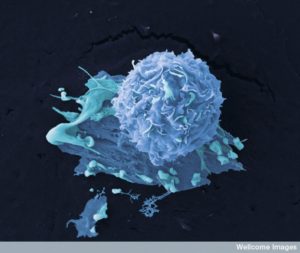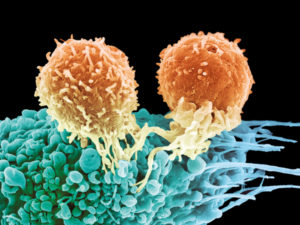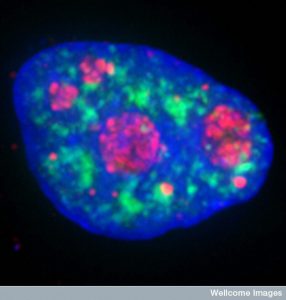 “The Secret Language of Cells … presents a new paradigm for understanding health and disease.”
“The Secret Language of Cells … presents a new paradigm for understanding health and disease.”
Andrew Weil, MD, director of the Andrew Weil Center for Integrative Medicine, professor at University of Arizona College of Medicine, and author
This new paradigm, described in my upcoming book, The Secret Language of Cells, is based on the newly-recognized principle that all physiological functions occur because of complex conversations among a wide variety of cells using an array of diverse signaling techniques. While this new view of biology is more complex than previously thought, understanding these elaborate cellular conversations provides many possibilities for new types of treatments. The findings related to cancer, described later in this post, are particularly revolutionary. Research no longer looks just at local events in one organ, but rather wide-ranging conversations among tissue cells, blood vessel cells, neurons, microbes, immune cells, and even cells in distant organs.
New advanced medical treatments for cancer, infectious diseases, immune diseases, chronic pain, food allergies, and brain disease are based on understanding these natural conversations that occur among varieties of cells.
Examples of these Conversations
♦ Food allergies are controlled by daily signaling among cells gut lining cells and immune cells. Understanding these signals will allow for the development of new food allergy treatments.
♦ Conversations occur among capillary cells and stem cells that determine the growth of particular organs. Understanding these signals will lead to the ability to regenerate tissues. Natural conversations among cancer cells, microbes, and immune cells have enabled the latest medical treatments for cancers by using microbes and T cells as treatments.
Natural conversations among cancer cells, microbes, and immune cells have enabled the latest medical treatments for cancers by using microbes and T cells as treatments.
♦ Natural interactions of viruses and human cells have led to virus-based treatments for cancer and other conditions. In the future, viruses might become the most effective antibiotic treatment for resistant infections.
♦ Conversations among immune cells and brain cells enable various functions never thought to involve both. For example, mental states are directly altered by signals from T cells that are not even residing in brain tissue. Conversations between immune cells and brain cells are directly related to stress, depression, chronic pain syndromes, and degenerative brain disease. Understanding these conversations is vital in the search for more effective treatments for these conditions.
♦ Gut lining cells and microbes collaborate to determine which microbes are friendly and which are, or will become, dangerous. These signals will enable us to provide new treatments for gastro-intestinal infections.
♦ When infections occur, conversations between capillary cells, organ lining cells, neurons, immune cells, and platelets call for white blood cells and give travel directions to the infection site. Once at the site, neutrophils signal to other cells to organize the attack; following the attack, they can stimulate chronic inflammation. Deciphering these neutrophil conversations with capillaries, other immune cells, and tissue cells will provide the ability to stop infections more rapidly and avoid chronic inflammation in tissues.
Revolution in Understanding Cancer
Cancer cells communicate among their own comrades for all group activities, including defense, just as microbe colonies do. Like microbes, they are able to send each other molecules to provide resistance against anti-cancer medications. Cancer cells send aid to developing cells and promote defense against immune attacks.

Additionally, cancer cells engage in advanced communication with many other types of cells to create and maintain their local growth and then spread the cancer to new metastatic colonies. Better understanding of these signals will lead to a wide range of new treatments.
Examples of Communication Signals used by Cancer Cells
♦ Exosomes: While cancers use a wide range of different types of signals, among the most important are small membrane-bound sacs released from the cancer cell, which are filled with information molecules such as RNAs, proteins, and peptides. When these sacs arrive at their target, molecules in the sacs dramatically alter the receiving cells in various ways that help the cancer. These sacs, called exosomes, are now an important diagnostic blood test for various cancers.
♦ Nanotubes: Cancer cells also send signals through networks of nanotubes to other cancer cells in their local community. These tubes are used to rapidly send genetic molecules, proteins, and even altered mitochondria that will specifically benefit other cancer cells by providing an increased energy supply.
♦ Secreted Signals: Cancer cells also use the more widely-known secreted signals, including immune cytokines and brain neurotransmitters, to communicate with a wide range of cells.
Examples of Cells that Cancers Manipulate with Signaling
♦ Local Tissue Cells: Using a variety of signals, cancers induce local connective and structural cells to help build new infrastructure for growing the cancer. Cancer cells communicate with neighboring tissue cells to seduce them into fighting along with the cancer against immune attacks. These neighboring cells also provide a protective barrier and, more dramatically, can change from stationary structural cells to mobile aggressive cells.
build new infrastructure for growing the cancer. Cancer cells communicate with neighboring tissue cells to seduce them into fighting along with the cancer against immune attacks. These neighboring cells also provide a protective barrier and, more dramatically, can change from stationary structural cells to mobile aggressive cells.
♦ Blood Vessel Cells: Cancers send signals to blood vessel cells to prompt them to produce new types of blood vessels that promote the growth of the cancer. These new blood vessels are unusual in that they prevent immune cells from leaving the new vessels and attacking the cancer.
♦ Neurons: Cancer cells communicate with neurons to trick them into sending signals, which are usually used to regenerate healthy tissue, to help grow the cancer. In the brain, cancer cells produce special electrical synapses with neurons, enabling them to feed off brain energy.
♦ Microbes: While it is well known that a significant percentage of cancers are caused by genetic actions of bacteria and viruses on human cells, many other microbes are beneficial to cancers in other ways. Some microbes can communicate with tumors to help them defend against immune attacks. Cancer cells can intercept and manipulate signals among microbes and immune cells to evade attacks. Microbes whose signals are naturally antagonistic to cancers can be used as treatments, such as specially engineered viruses designed to attack particular cancers.
♦ Immune Cells: Immune cells naturally chase and attack cancer cells, but some cancers are able to manipulate  immune signals to avoid attacks and even to help the cancer grow. Many of these immune cells that have been transformed into allies live inside of the tumor in large numbers and help form the cancer’s structure.
immune signals to avoid attacks and even to help the cancer grow. Many of these immune cells that have been transformed into allies live inside of the tumor in large numbers and help form the cancer’s structure.
♦ Platelets: Cancers can manipulate platelets to their cause by stimulating them to cover the tumor to protect it from attack.
♦ Metastatic Colonies: Cancer cells understand their local tissues’ signals, which are often unique to a particular organ. But cancers are also able to learn the language of particular distant organs. Using special signals, they can communicate with these distant tissues—such as lung, liver, bone, and brain—to help build a new metastatic colony. Distant conversations often use exosomes filled with genetic molecules and other signals that influence the landing site to provide a friendly environment for the cancer.
Understanding these natural conversations will allow a large number of new avenues for cancer treatment.
“The Secret Language of Cells takes us on an exciting journey into a world where we can visualize elaborate  conversations among immune cells, brain cells, gut cells, bacteria, and even viruses. Dr. Lieff gives a wealth of examples for his thesis that this cellular signaling is the basis of life. It is a must read for anyone seeking to understand modern biology and advanced medical science. It is equally important for those of us who wonder, as I do, how this ubiquitous information transfer in the form of cellular conversations might be related to the emergence of intelligence and consciousness.”
conversations among immune cells, brain cells, gut cells, bacteria, and even viruses. Dr. Lieff gives a wealth of examples for his thesis that this cellular signaling is the basis of life. It is a must read for anyone seeking to understand modern biology and advanced medical science. It is equally important for those of us who wonder, as I do, how this ubiquitous information transfer in the form of cellular conversations might be related to the emergence of intelligence and consciousness.”
Ray Kurzweil, inventor, author, and futurist
“Through a brilliant synthesis of cellular biology, microbiology, immunology, and neuroscience, The Secret Language of Cells offers a lucid explanation of the marvelous intricacies of cellular life. The result is a masterful exploration of the profound implications of cellular intelligence for understanding pathophysiology, human health, and even our origins.”
Miller, Jr., MD, physician, biologist, author of The Microcosm Within: Evolution and Extinction in the Hologenome, and internationally recognized expert on Cognition-Based Evolution
“Jon Lieff’s description of cellular communication is insightful, provocative, illuminating, and engaging and provides deep and novel observations into the remarkable symphony of how life happens. Mimicking the cellular world he describes, Dr. Lieff is the great communicator and muse of living things. An inspiring and informative read.”
Ted Kaptchuk, professor of medicine at Harvard Medical School
“This journey into the dynamic realm of cellular conversations is a tour-de- force—fascinating, vital, and especially timely for understanding emerging viruses. As we learn about intelligence in smaller and smaller animals, it’s not surprising that the tiniest creatures—microbes and even viruses—exhibit elaborate communication and complex decision making. Read The Secret Language of Cells!”
Marc Bekoff, PhD, professor emeritus of ecology and evolutionary biology at the University of Colorado, Boulder and author of Canine Confidential: Why Dogs Do What They Do
Purchase Book Here
 “The Secret Language of Cells … presents a new paradigm for understanding health and disease.”
“The Secret Language of Cells … presents a new paradigm for understanding health and disease.”